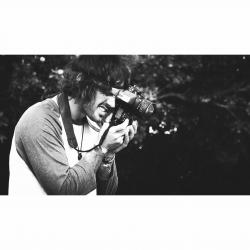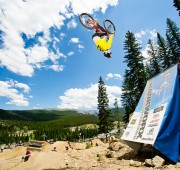10 Tips for Better In-Line Skate Photography
Rollerblading Photography has been a blessing in disguise, with an industry that is the smallest it has ever been its fair to say that there is no real career in being a rollerblading photographer.
At first I found this quite a bitter pill to swallow, thinking back to the more affluent times in it's history made me angry and bitter at the state of affairs. Still I kept shooting for the love of a sport I have grown up with, and to help promote and support a industry that needed building from the ground up. Years later I can see these years have not been a waste at all, and that all my hard work has been beneficial to myself as a working photographer and to the Rollerblading industry.
Being a rollerblader of 16 years myself has given me a huge advantage with shooting the sport as I have an in-depth knowledge of the tricks and the abilities of the people I shoot. Now, as a recognized photographer within the rollerblading scene, I find my work published in some of the biggest publications, used in ads for brands, and becoming a named collaborator with one of the UK's best clothing brands.
The years of hard work have been tough going at times, but the rewards are there to be seen. All the techniques learned have been transferred into producing work on a commission basis outside of rollerblading. Although not solely sufficient upon the income photography brings in yet, I'm happy knowing I'm on the way and as such would love to pass down a little knowledge on how to shoot better rollerblading images as I know without peoples help down the years I would have struggled more.
So thank you for reading and enjoy my top ten tips…
1. Get a Good Body
Its important to know the camera body you have is going to produce the goods. These days you can pick up great camera bodies that are fast and produce great looking images for a very reasonable price. When shooting rollerblading, 99% of the time you will be using strobes and there is one small feature in a camera that many over look only to realize later on down the line. The flash sync rate is what depicts how fast the shutter can go off before it is too fast for the flash unit to keep up with. You will find you will not be able to control the lighting of the scene/subject and freeze the action at the same time which will result in either washed out, over exposed images, or action that can't be frozen enough and thus will be blurry. The body really doesn't affect the flash sync speed, but a good body is important none-the-less.
2. Bag It Up
Shooting rollerblading is very much a location based activity. Shoots can rapidly move from the comfort of a skate park, out into a range of different environments and locations on the streets. With that in mind a decent size bag that can fit all your equipment is a must. The comfort and speed in which you can get your equipment in and out of the bag also needs to be considered because there is alot of moving from spot to spot in quick succession.
3. Dress For The Occasion
Being the photographer is some what different to being the athlete, while they might be getting too warm and stripping layers off, you can be sure that as the snapper you will be wishing you had more layers. Long periods of not doing much as your subject gets ready to perform can leave you frozen to the core. Make sure when you go out on a shoot you wear more layers than needed, its better to have to remove a few items of clothing than need more layers that you don't have with you.
4. Clean Lens, Clean Mind
There is one thing that bugs me more than anything else, and that is a horrible grubby lens. Rollerblading shots are not captured in a nice clean studio, they are a product of the real world. A part of shooting on location in the streets of the UK is the dirt, dust and grime, it is this fact that makes it a absolute must that you have either a lens pen or cloth on hand to keep that glass crystal clear and ready for the next shot.
5. Listen & Learn
Knowledge is key no matter what extreme action sport you shoot within. If you don't understand the sport and the tricks within it you will never know when that pivotal moment is during a trick, or what the best angle is to shoot it from. Talk to your subject about what they are doing and how they are doing it. Even I consult with my subjects if i'm slightly unsure or cant decided on a angle as to get a second option to help with my final decision. These people normally have been doing what they do for years and have a great knowledge of the best way to document the tricks they perform.
6. Location Location Location
You will find that when shooting extreme sports you will be taken to some great locations with loads of character, but I've found over the last few years rollerblading has gone through alot of change, and there is now more of a thirst for more unique and interesting spots. This natural development within the sport has been a blessing to those who are documenting. Instead of shooting very similar looking hand rails over and over again, you can now be assured that each spot you go to will provide you with a totally different obstacle and scene. As well as capturing the trick, make sure you try to capture the location, you can do this by using elements of the scene in the fore and back ground to give a feel of the location and to help compose your image well. Documenting the location as well as the trick is important as they both compliment each other in different way and help make a better all round image.
7. Its Time For Your Close Up
Extreme action sports are exciting, adrenaline fueled activities by there own nature and rollerblading is no exception to this rule. The most well known and obvious way to capture and convey that feeling is through getting up close and personal using an extremely wide lens like a fisheye. The distortion helps to somewhat exaggerate the scene making everything seem bigger. Mix that with how unnaturally close you can get to the subject this really helps to produce dynamic and exciting images.
8. Flasher
Flash units are pretty much a requirement when shooting rollerblading, 99% of the shots I have taken of rollerbladers have had the use of at least one strobe. With such fast moving subject the flashes can be used to help freeze the action, as well as give you the option to shoot during night or when there is minimal natural light. It's not just a simple as buying a flash unit though, having the ability to get your units off the camera as to move around your scene is what can make the difference between a good image and a truly great image. With well thought out flash placement your images will have great depth, show signs of better flash control and look more natural which will result in a better all around image.
9. Pre Focus
There is nothing worse than returning home after a shoot with what you think is a stunner of an image, only to find that when up on the big screen your focusing is not quite right. This is something that all photographers have suffered at the hands of. To make sure you get it right when shooting rollerblading plan out where you want to take your snap and pre-focus on the area. Once you are happy, take a test shot and check its right and repeat this process till it's correct if need be. if you are having trouble getting it right due to low lighting or a lack of features in the scene, don't be afraid to ask your subject to stand in the appropriate place as to give you something to focus upon.
10. Have Fun & Experiment
At the end of the day this is all meant to be fun, so don't get too weighed down with all the do's and don'ts, they are only there to guide you to a basic understanding. Bend and break the rules once you feel you understand them well enough, Its only though experimentation that you will ever find something new and interesting in your quest to capture great images.
















No comment posted yet.